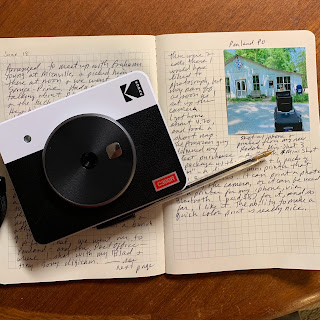Last month, I received a nice little package from Reflx Lab. In it, was a sample of their new accessory light meter for me to evaluate. Over the course of several weeks, I kept the meter on my black-bodied Pentax Spotmatic SP, and used it to shoot three rolls of film.
In the past 4 years or so, a lot of small shoe-mounted light meters have come on the market. In 2021 I reviewed the Doomo-D analog-style meter and in 2022, the tiny Cooldark V102 light meter.
I love this little meter - it’s simple to use, and once you go to the Reflx Lab web site, you can find the instructions for the meter (a QR code is on the meter’s package). Unlike some of the other tiny meters available, this one has a beautiful aluminum shell, not a rough 3D printed plastic body. Aesthetically, it’s one of the sleekest and most unobtrusive shoe-mounted meters available. I like the easy to read LCD readout, and there’s not much fussing about involved to get a reading. Power-wise, it takes a CR1632 3v button cell, which came with my meter. In use, I especially enjoyed the larger and easy to read display over those tiny OLED displays.
Is it accurate? Yes. It has a 30-degree angle of metering, and when shooting and comparing the reading with an in-camera light meter, it usually agreed. The ISO setting range is 8-6400, which ought to be enough for 95% of the users. Since I often use really low-ISO films, I’d love it if the meter went as low as ISO 1. However, I can do the math and compensate when using extra-low ISO film. When I am out shooting with my Spotmatic, I’m often inclined to use the sunny-16 rule, and then check what I think it should be with what the Reflx Lab meter tells me. Those really hazy days that we have been experiencing can fool the eye, and what might normally be an f/16 sunny day has become an f/11 or f/8 sunny day. The meter reads out either in Aperture-Priority or Shutter-Priority, which I find perfect for my use. It’s ease of use and performance, makes it a go-to accessory meter. The other great thing about this meter is the price — as it sells for less than $50.
The Reflx Lab Light Meter is well-designed, accurate, easy-to-use, and inexpensive. All good things in my opinion.
Specifications:
- Material: zinc, aluminum, & PC plastic
- Color: Black or Silver
- Metering Angle: 30-degree average metering
- Shoe bracket position: left, center, or right (adjustable)
- Dimensions: 35mm x 28mm x 11.5mm (1.4inch x 1.1inch x 0.45inch)
- Weight: 25g (0.88oz)
- Working Temperature: -12°C-60°C
- Battery: CR1632 x1 (NOT INCLUDED)
- ISO Range: 8-6400
- Shutter Range: 30s-1/8000s
- Aperture Range: 1-32
- Exposure Compensation: -2 to +2
You can download the manual here: https://cdn.shopify.com/s/files/1/0608/4594/9094/files/REFLX_LAB_Light_Meter_User_Manual.pdf?v=1686927597
If you are looking for a small, easy to use light meter that fits into the hot/cold shoe on your camera, give this one a try. Check my post on the Reflx Lab Pro Color 100 film to see the outcome with using this meter.












































